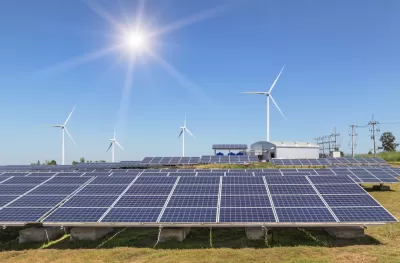As more wind and solar plants get built in remote locations, utilities must figure out how to transport and store energy over increasingly vast distances.

Renewable energy sources are slowly gaining a foothold in the United States, but as Gregory Barber writes, our electric grid isn't quite ready for them. "Since 1889, when the US got its first long-distance power line (it traversed a whopping 14 miles), the grid largely has been set up for energy that’s consumed relatively close to where it is produced." But with renewables like wind and solar requiring vast swaths of space in far-off places, utility companies will have to improve their ability to harness and transport that power to where it's needed.
According to Princeton researchers, meeting national clean energy goals requires increasing the nation's high-voltage transmission capacity by 60 percent. Today, some production facilities are actually forced to shut down when they are producing too much power to transmit over outdated wires.
For plants that are yet to be built, the situation is even worse, because grid constraints mean backers must string new lines, and pay for them, before installing turbines or solar panels. Each year, hundreds of renewable energy projects stall in advanced planning stages due to delays in upgrading transmission lines and the cost of making those upgrades.
Barber describes research being done into 'grid-enhancing tools' that can boost the amount of power that lines can carry and improve flexibility during variable supply and demand periods. But experts say that "[t]echnologies that enhance the existing grid are one part of a much bigger puzzle." Creating a grid that can effectively harness wind and solar energy and meet future demand while preparing for the effects of extreme weather will require a comprehensive plan spanning multiple agencies and users.
FULL STORY: Renewable Energy Is Great—but the Grid Can Slow It Down

Alabama: Trump Terminates Settlements for Black Communities Harmed By Raw Sewage
Trump deemed the landmark civil rights agreement “illegal DEI and environmental justice policy.”

Planetizen Federal Action Tracker
A weekly monitor of how Trump’s orders and actions are impacting planners and planning in America.

The 120 Year Old Tiny Home Villages That Sheltered San Francisco’s Earthquake Refugees
More than a century ago, San Francisco mobilized to house thousands of residents displaced by the 1906 earthquake. Could their strategy offer a model for the present?

Ken Jennings Launches Transit Web Series
The Jeopardy champ wants you to ride public transit.

BLM To Rescind Public Lands Rule
The change will downgrade conservation, once again putting federal land at risk for mining and other extractive uses.

Indy Neighborhood Group Builds Temporary Multi-Use Path
Community members, aided in part by funding from the city, repurposed a vehicle lane to create a protected bike and pedestrian path for the summer season.
Urban Design for Planners 1: Software Tools
This six-course series explores essential urban design concepts using open source software and equips planners with the tools they need to participate fully in the urban design process.
Planning for Universal Design
Learn the tools for implementing Universal Design in planning regulations.
Clanton & Associates, Inc.
Jessamine County Fiscal Court
Institute for Housing and Urban Development Studies (IHS)
City of Grandview
Harvard GSD Executive Education
Toledo-Lucas County Plan Commissions
Salt Lake City
NYU Wagner Graduate School of Public Service





























